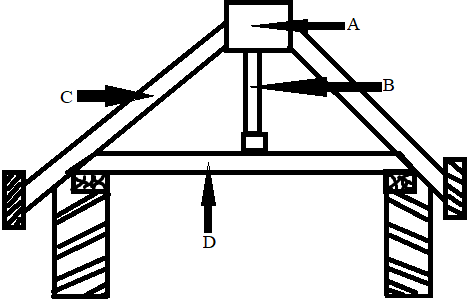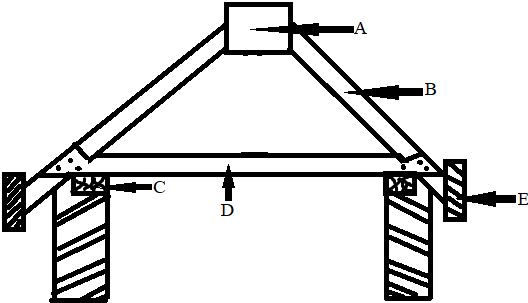This set of Building Construction Multiple Choice Questions & Answers (MCQs) focuses on “Single and Double Roofs”.
1. Which of the following is not a type of single roof?
a) Lean-to-roof
b) Couple roof
c) King-post roof truss
d) Collar beam roof
View Answer
Explanation: There are five types of single roofs. These are lean-to-roof, couple roof, couple close roof, collar beam roof and collar and scissors roof. Single roofs consist of only the rafters which are supported at the ridge and the wall plate.
2. _________ joint is used to connect the wooden tie and the feet of rafters in a couple of close roof.
a) Dovetail halved
b) Closed mortised and tenoned
c) Pin and tenoned
d) Open and pin
View Answer
Explanation: Dovetail halved joint is used to connect wooden tie and the feet of rafters in a couple of close roof. In a couple close roof, the ends of the couple of common rafters are connected a tie beam. It is used to prevent the rafters from spreading out of the wall.
3. A couple roof is suitable for spans up to _________
a) 3.6 metres
b) 4.2 metres
c) 5.6 metres
d) 6.3 metres
View Answer
Explanation: A couple roof is suitable for spans up to 3.6 metres. This type of roof has a great tendency to spread out at the wall plate level. However, a couple close roof is usually used when the span is limited to 4.2 metres.
4. Which of the following is also known as a pent roof?
a) Lean-to-roof
b) Couple roof
c) Couple-close roof
d) Collar beam roof
View Answer
Explanation: Lean-to-roof is also known as a pent roof. It is also known as the aisle roof. Lean-to-roof is the simplest type of sloping roof. In this, rafters’ slope to one side only.
5. How many elements are generally there in a double roof?
a) One
b) Two
c) Three
d) Four
View Answer
Explanation: There are basically two elements in a double roof. These are rafters and purlins. The purlins provide intermediate support to the rafters.
6. Triple-membered roofs are also known as _______
a) Verandah roofs
b) Collar tie roofs
c) Purlin roofs
d) Trussed roofs
View Answer
Explanation: Triple-membered roofs are also known as trussed roofs. A triple-membered roof is used when the length of the room is large and the span of the room exceeds 5 metres.
7. Which of the following roof is also known as rafter roof?
a) Double roof
b) Lean-to-roof
c) Couple-close roof
d) Couple roof
View Answer
Explanation: Double roof is also known as rafter roof or purlin roof. Double roofs are used when the span exceeds 5 metres. Purlin is used to tie the rafters together.
8. Lean-to-roof is suitable for maximum span of ______
a) 1.3 metres
b) 2.5 metres
c) 3.6 metres
d) 4.2 metres
View Answer
Explanation: Lean-to-roof is suitable for a maximum span of 2.5 metres. These types of roofs are generally used for sheds, verandahs etc. Hence, they can also be called verandah roofs.
9. The central vertical rod provided in the couple close roofs is called as ________
a) King rod
b) Queen post
c) King post
d) Queen stone
View Answer
Explanation: The central vertical rod provided in the couple close roofs is called king rod. Its function is to connect the tie beam and the ridge piece.
10. Tie beam is used in collar beam roofs.
a) True
b) False
View Answer
Explanation: Tie beam is a horizontal member which is used in a couple close roof. It is provided at the level of the wall plates whereas, in a collar beam roof, a raised beam known as a collar beam is used. Collar beam is also known as a collar tie.
11. The thickness and the width of an eaves board are generally ______ and _____ respectively.
a) 10 mm, 10 mm
b) 10 mm, 20 mm
c) 25 mm, 25 mm
d) 15 mm, 25 mm
View Answer
Explanation: Eaves board is a wooden board which is fixed to the feet of the common rafters at the eaves. The thickness and the width of an eaves board are generally 25 mm and 25 mm respectively.
12. Which of the following is not a type of roof truss used in triple-membered roofs?
a) Mansard roof truss
b) King-post roof truss
c) Truncated roof truss
d) Collar beam roof truss
View Answer
Explanation: The various types of truss used in triple-membered roofs are mansard roof truss, king-post roof truss, queen-post roof truss, truncated roof truss etc. A collar beam roof is a type of single roof which is also known as a collar tie roof.
13. B in the figure given below represents __________

a) Ridge piece
b) King rod
c) Rafter
d) Tie beam
View Answer
Explanation: The above figure shows a close couple roof. In this figure, A represents ridge piece, B represents king post, C represents rafter and D represents tie beam. A king post is a vertical rod placed at the centre which joins the ridge piece and the tie beam.
14. In the figure of the collar beam roof given below, D represents ______

a) Ridge piece
b) Tie beam
c) Collar beam
d) Rafter
View Answer
Explanation: The figure given above is of a collar beam roof. In this figure, A represents ridge piece, B represents rafter, C represents wall plate, D represents collar beam and E represents eaves board. The collar beam is provided at a raised level.
15. In a collar tie roof, a higher collar position gives a stronger roof.
a) True
b) False
View Answer
Explanation: In a collar tie roof, a lower collar position gives a stronger roof. A collar tie roof is usually used for spans up to 5 metres.
Sanfoundry Global Education & Learning Series – Building Construction.
To practice all areas of Building Construction, here is complete set of 1000+ Multiple Choice Questions and Answers.
If you find a mistake in question / option / answer, kindly take a screenshot and email to [email protected]
- Practice Civil Engineering MCQs
- Check Construction and Building Materials Books
- Apply for Civil Engineering Internship
- Check Civil Engineering Books
